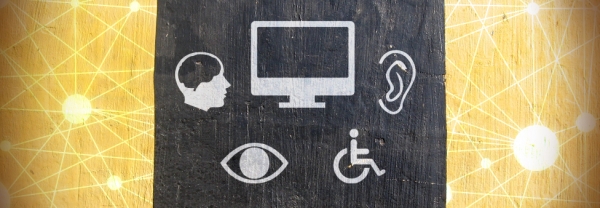by: Andrea Flores
 Conversations about Diversity In 2014, HGSE launched the Fulfilling the Promise of Diversity (FPD) initiative to foster and sustain community-wide conversations and learning experiences around the topics of equity, diversity, and inclusion. Most often the conversation centers around face-to-face learning environments through the lens of race and socioeconomic status (SES).
Conversations about Diversity In 2014, HGSE launched the Fulfilling the Promise of Diversity (FPD) initiative to foster and sustain community-wide conversations and learning experiences around the topics of equity, diversity, and inclusion. Most often the conversation centers around face-to-face learning environments through the lens of race and socioeconomic status (SES).
One aspect of diversity that is not often discussed (but does affect the design of online learning environments) is accessibility. Unlike in a traditional classroom where the majority of the interaction occurs directly between people, online learning requires a computer or other device to mediate interactions between and among people and content. Therefore, if a person cannot interact with the machine in “typical” ways, how might their learning experience be impacted?
This question prompted my participation in a week-long online workshop on the American Disabilities Act (ADA) and the Fundamentals of Web Accessibility. The goals of the workshop were for participants to better understand the legal framework guiding design for accessibility, to highlight how students with varying abilities learn online, and to explore ways to design more ADA compliant courses.
The Legislation The primary piece of legislation for students with disabilities is the American Disabilities Act (ADA), which was signed into law in 1990, and ensures equal access to programs and services in higher education. Two other relevant pieces of legislation are Sections 504 and 508 of the Rehabilitation Act of 1973. Section 504 states that institutions are required to provide equal access to programs and services receiving federal funding, while Section 508 requires that federal websites have minimum benchmarks for website accessibility. As I learned about this legislation, I wondered whether simply giving disabled students access to a course was equivalent to providing access to the full educational experience that a non-disabled student has, particularly online?

The Student Experience As it turns out, simply providing access is not sufficient to make a learning experience truly accessible. On the surface, access to a course via the online environment looks promising for those with disabilities. Physically disabled students can work from home and don’t have to arrange transportation or ensure that classrooms are accessible for them. Blind or visually impaired students can control audio settings on course videos, and deaf students won’t need an interpreter because they can access transcripts. Students with non-visible disabilities, such as those with psychological or learning disabilities, can work at their own pace in a setting that is comfortable for them.
While all of the above are certainly benefits that technology can provide to students, other nuances can make true access difficult. For instance:
- A blind or visually impaired (BVI) student may have course content that is accessible, but if the first assignment requires conducting research on the web, then they may encounter sites (and information) that are not designed for accessibility. Also, because information presented on the web is increasingly relying on glossy visuals and animations to engage the user and reduce textual information, this presents challenges for BVI students who may miss out on these entirely.
- For the deaf or hearing impaired, “engaging” video clips that are embedded in presentations will not be accessible unless a transcript or narrated audio track is provided. Furthermore, having to participate in online speaking presentations or web conferences could add further difficulty.
- For students with physical limitations that make typing or moving a mouse difficult, participating in live chats that require spontaneous typing or navigating a course site with small font or closely spaced links can be an extremely frustrating experience.
- For students with more hidden disabilities such as ADD or ADHD, online learning may pose greater challenges for them as the Internet is teeming with distractions, and time management relies more heavily on the learner.
Implications, Strategies, and Looking Ahead With all of these considerations, it is evident that thoughtful design and planning are needed to provide a truly accessible online course in keeping with our commitment to Fulfilling the Promise of Diversity. Some of the key takeaways from the workshop include:
- Take a preventative rather than a reactive approach by considering accessibility at the beginning of the course design process
- Allow appropriate time for these considerations during the planning phase of a project
- Create or use existing guidelines and checklists to address accessibility standards
- Design and conduct user testing to also test for accessibility
- Use the Universal Design for Learning framework to design for multiple modes of representation and expression for ALL students
Envisioning and operationalizing sound practices that lead to equity and inclusion are not easy tasks. With small steps and deliberate and thoughtful planning, we at the TLL seek to infuse the work we do with consideration and empathy for those whose voices are not always heard. In doing so, we ensure that HGSE’s commitment to providing equitable and inclusive learning experiences for ALL students can be fulfilled.
